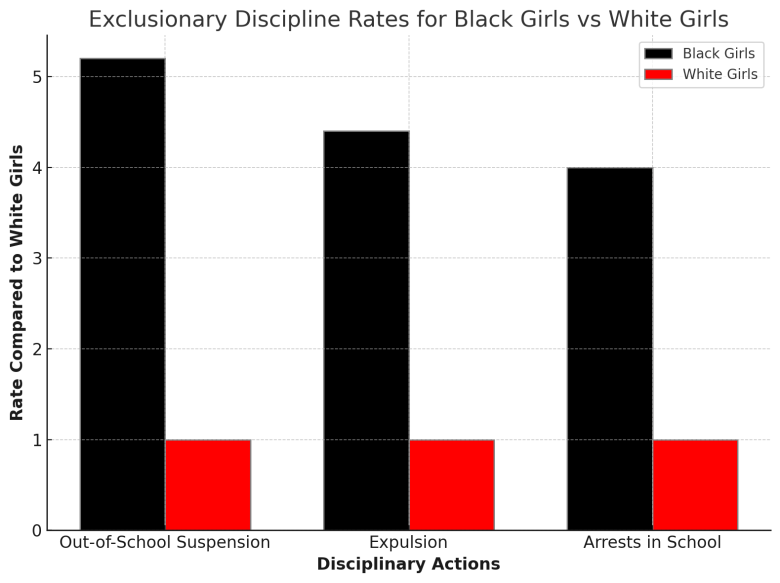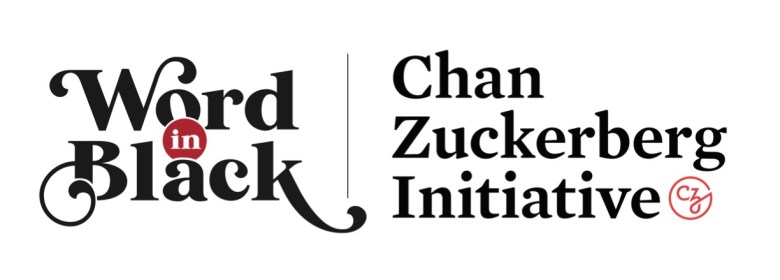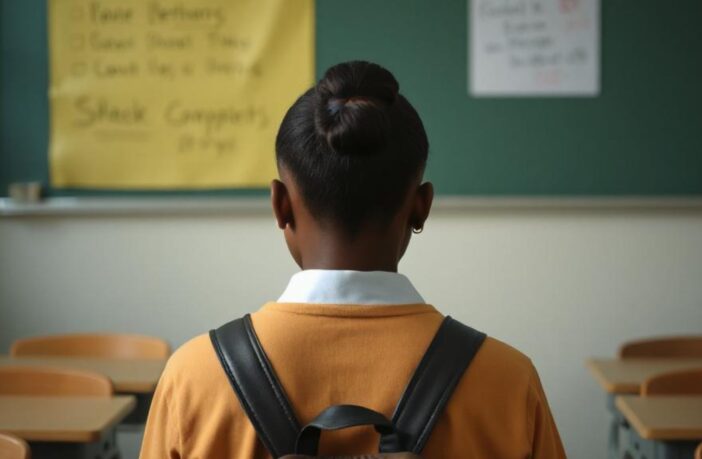By Quintessa Williams
Word in Black
It’s no longer a surprising revelation that Black girls are disciplined at disproportionately high rates compared to their peers of other racial backgrounds.
However, new data from two women’s advocacy organizations and the federal government has further shed light on this persistent trend. Black girls, who make up just 15 percent of public school students, are far more likely than White girls to be suspended for behavior issues — and face exclusionary expulsion and corporal punishment as early as preschool.
Studies show that due to adultification, Black girls are often punished at a rate higher than their White counterparts in the classroom.
Credit: AI photo generated by Fotor AI
A 2024 report from the National Black Women’s Justice Institute found that Black K-12 girls represented more than three times their enrollment share in transfers and corporal punishment and more than double their share in expulsions. This data has been bolstered by a new report from the Government Accountability Office, which found that in the 2017-2018 school year, Black girls accounted for nearly half of all exclusionary discipline cases — including 45 percent of out-of-school suspensions, 37 percent of in-school suspensions, and 43 percent of expulsions.
This disparity also echoes the findings from the National Women’s Law Journal and Ed Trust, which reported that in the 2015-2016 school year, Black girls were five times more likely than their White peers to be suspended. In addition, the report also found that as early as preschool, Black girls made up 20 percent of the female enrollment but accounted for 53 percent of out-of-school suspensions.
Bayliss Fiddiman, senior director of educational equity at NWLC, tells Word In Black that the new findings illustrate the uphill battle Black girls face in school.
“These disparities have existed for years, but the GAO report is a stark reminder that little has changed,” she said. “The data reinforced what we already knew as a problem — Black girls are subject to harsher disciplinary actions for behaviors that are often perceived through the lens of bias, such as defiance or disruption.”
Adultification and colorism contribute to the disparity
The GAO identified that the disproportionate discipline of Black girls is due to a range of factors, including poverty levels, disabilities, and the presence of school resource officers. However, racial bias — particularly via adultification and colorism — plays the most significant role.
“Teachers and school staff often perceive Black girls as older and more mature than they are, which means they are seen as more ‘responsible’ for their actions and are punished more severely than their peers,” says Dr. Sydney McKinney, executive director of the National Black Women’s Justice Institute. “This bias manifests in labeling typical teenage behavior as ‘disrespect’ or ‘disruption,’ and Black girls often bear the brunt of these stereotypes.”
Fiddiman also elaborated on the colorism factor: “Black girls with darker skin are undoubtedly more likely to be punished than those with lighter skin,” she says. “It’s an unfortunate extension of the racial bias that permeates school discipline systems.”
 Shown here, a bar graph chart showing the exclusionary discipline rates where Black girls faced 5.2 times the rate of out-of-school suspension, 4.4 times the rate of expulsion, and 4 times the rate of arrests in school for behaviors such as defiance, disrespect and disruption, according to data from the Government Accountability Office.
Shown here, a bar graph chart showing the exclusionary discipline rates where Black girls faced 5.2 times the rate of out-of-school suspension, 4.4 times the rate of expulsion, and 4 times the rate of arrests in school for behaviors such as defiance, disrespect and disruption, according to data from the Government Accountability Office.
Credit: Graph courtesy of Government Accountability Office via Word in Black
Black girl discipline is a national public crisis
The discipline crisis among Black K-12 girls spans every state in the U.S. McKinney pointed to the long-standing trends in exclusionary discipline data from the 2024 NBWJI report. “Our data from 2011 to 2018 shows consistent overrepresentation of Black girls in nearly every category of discipline—whether it’s suspensions, expulsions, or referrals to law enforcement,” she says. “This consistency over time is perhaps the most alarming aspect. It’s clear that little progress has been made despite awareness of the issue.”
The over-punishment of Black girls in schools is not a recent phenomenon but part of a broader historical trend of excessive discipline rooted in racial and gender biases. That includes corporal punishment in the classroom.
In Arkansas, for example, an 8-year-old Black girl was paddled for refusing to do her schoolwork. The administrator involved later acknowledged the harm caused by such punishment, especially when disproportionately applied to Black students.
A 2019 report by the Southern Poverty Law Center and the UCLA Center for Civil Rights Remedies later found that Black girls like the 8-year-old are paddled at three times the rate of White girls.
This article was originally published by Word in Black.




